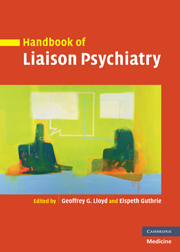Book contents
- Frontmatter
- Contents
- List of contributors
- Preface
- Part I Basic skills
- Part II Common psychiatric problems across the general hospital
- Part III Working with specific units
- 14 Neurological disorders
- 15 Cardiorespiratory disorders
- 16 Gastrointestinal disorders
- 17 Liver disorders
- 18 Endocrine disorders
- 19 Diabetes
- 20 HIV and AIDS
- 21 Renal disease
- 22 Musculo-skeletal disorders
- 23 Oncology
- 24 Head and neck cancer
- 25 Palliative care
- 26 Cosmetic procedures
- 27 Perinatal and gynaecological disorders
- 28 The intensive care unit
- 29 The burns unit
- 30 Psychocutaneous disorders
- 31 Genitourinary disorders
- 32 The emergency department
- Part IV Treatment
- Part V Different treatment settings
- Index
- References
32 - The emergency department
from Part III - Working with specific units
Published online by Cambridge University Press: 10 December 2009
- Frontmatter
- Contents
- List of contributors
- Preface
- Part I Basic skills
- Part II Common psychiatric problems across the general hospital
- Part III Working with specific units
- 14 Neurological disorders
- 15 Cardiorespiratory disorders
- 16 Gastrointestinal disorders
- 17 Liver disorders
- 18 Endocrine disorders
- 19 Diabetes
- 20 HIV and AIDS
- 21 Renal disease
- 22 Musculo-skeletal disorders
- 23 Oncology
- 24 Head and neck cancer
- 25 Palliative care
- 26 Cosmetic procedures
- 27 Perinatal and gynaecological disorders
- 28 The intensive care unit
- 29 The burns unit
- 30 Psychocutaneous disorders
- 31 Genitourinary disorders
- 32 The emergency department
- Part IV Treatment
- Part V Different treatment settings
- Index
- References
Summary
Introduction
Assessing and managing patients with mental health problems or substance misuse problems in the emergency department (ED) is one of the most crucial and challenging aspects of psychiatric practice in general hospitals. However, it has long been an unpopular, neglected, risky and rather controversial task. It remains unpopular with patients, mental health professionals and ED staff alike, though each group has its own distinct issues. Patients complain of an unsuitable physical environment, lack of privacy, long delays before being seen and inappropriate decision-making. Consultant psychiatrists have understandably shied away from taking responsibility for numerous high-risk decisions made under pressure of time by a large number of different trainee psychiatrists at all hours of the day and night. Academic psychiatrists have, with a few notable exceptions, avoided the ED as a research area so there is not yet much evidence to guide practice. Emergency department staff may see patients with mental health and substance misuse problems as a numerically small, but potentially high-risk, group and quietly resent being the unacknowledged out-of-hours support to local community mental health services.
Before the situation can be improved nationally one question has to be settled. Is mental health work in the ED simply emergency community psychiatry being practised in the wrong setting because of a lack of planning and resources (Harrison & Bruce-Jones 2003), or is it an example of a specialist liaison psychiatry service to a single department of the general hospital (Cassar et al. 2002; Henderson et al. 2003)?
- Type
- Chapter
- Information
- Handbook of Liaison Psychiatry , pp. 751 - 760Publisher: Cambridge University PressPrint publication year: 2007



